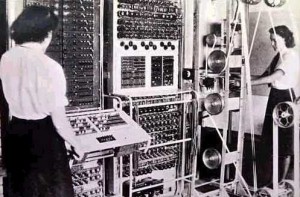The development of Digital Natives as a concept can trace its roots through the history of computers.
- Through the 70’s and 80’s computers went from being the size of your house to something you could have in a room in your house.
- Through the 80’s and 90’s computers became mobile with the development of the laptop.
- From the 2000’s to the present, mobility became miniaturized and smart phones developed the same power as previous generation laptops.
To put this evolution into context it is useful to compare a roughly standard mobile device to the Apollo Guidance Computer that took Apollo 11 to the moon in 1969.
| Apollo Guidance Computer | Smart Phone | Difference | |
| RAM size | 4KB | 4GB | 1,000,000x larger |
| RAM speed | 8MB/s | 6400MB/s | 800x faster |
| Weight | 32kg | 100g | 3200x lighter |
| Cost | $150,000 | $500 | 300x cheaper |
| Power needs | 70W | 1.3W | 50x more efficient |
In 1997 the IBM supercomputer Big Blue won a series of chess games against Gary Kasparov. The processing power of Big Blue is listed as 11.38 GigaFlops. Simply put, Big Blue could process 11,380,000,000 instructions / sec. Tianhe-2 the Chinese supercomputer currently viewed as the most powerful in the world has a theoretical peak of 54,902.4 TeraFlops or 54,902,400,000,000,000 instructions / sec. Tianhe-2 is 4,824,464 times more powerful than Big Blue.
This development curve is moving toward an event that futurists call Technological Singularity.
“The technological singularity hypothesis is that accelerating progress in technologies will cause a runaway effect wherein artificial intelligence will exceed human intellectual capacity and control, thus radically changing civilization”.
Ray Kurzweil the futurist who coined the term predicts that a computer will have the ability to ‘think for itself’ likely by the year 2029.
In the midst of this hardware development Tim Berners Lee invented the internet in 1989. Around the same time, the scientists at CERN in Switzerland developed email. In subsequent years Hackers have developed software that has enabled the emergence of botnets. This is malicious software (also known as malware) that can turn your computer into a bot (also known as a zombie). When this occurs, your computer can perform automated tasks over the Internet, without you knowing it. Hackers typically use bots to infect large numbers of computers. These computers form a network, or a botnet. Botnets become effective supercomputers existing virtually on the internet.
The biggest botnet unearthed on the internet to date was called BredoLab and had the capacity to send 3,6 billion spam emails a day.
| Date created | Date Dismantled | Name | Estimated # of Bots | Spam Capacity |
| May 2009 | Oct 2010 | BredoLab | 30,000,000 | 3,6 billion / day |
This is the world into which Gen Y were born. In 2001 Mark Prentsky wrote a research paper and coined the term Digital Natives. In the paper he focused on the impact that this technological evolution has had on education. In subsequent years this label has been broadened to cover the complete life experience of Gen Y, and in time, Gen Z (children currently under-12).
Digital Natives are the product of the world Baby Boomers and Gen X created through the technology they unleashed on the world. These Natives will continue to expand the application of this tech into all facets of their lives whether work, social, community, professional, or personal.
Sources:
http://superuser.com/questions/747202/how-do-modern-smartphones-compare-to-apollo-mission-computers
http://en.wikipedia.org/wiki/Technological_singularity
http://www.thatsreallypossible.com/the-singularity/
http://en.wikipedia.org/wiki/Botnet
http://www.microsoft.com/security/resources/botnet-whatis.aspx




